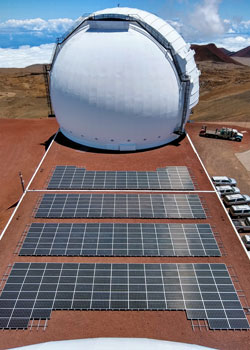
The W. M. Keck Observatory on University of Hawaiʻi-managed lands on Maunakea on Hawaiʻi Island has completed a solar photovoltaic (PV) system project.

The PV system on the rooftop of Keck Observatory’s telescope facility will produce more than 259 MWh of energy and reduce approximately 10–15% of the observatory’s need for electrical power and 183 metric tons of carbon emissions.
The solar site is the world’s largest commercial solar system installed at the highest altitude. Hawaiian Electric approved operation of the PV system on September 30. It consists of a 133-kW PV array and 332 solar panels that are strategically placed on the unique 20,940 square-foot ballasted roof to avoid snow and ice fall from the domes.
At high altitude, the panels will catch more photons and produce more energy than at sea-level locations. This is because sunlight atop Maunakea doesn’t have to travel through as much of the Earth’s atmosphere where the photons could be absorbed by something else. Having 40% less atmosphere is one feature that makes Maunakea one of the best places on Earth to conduct astronomy.

